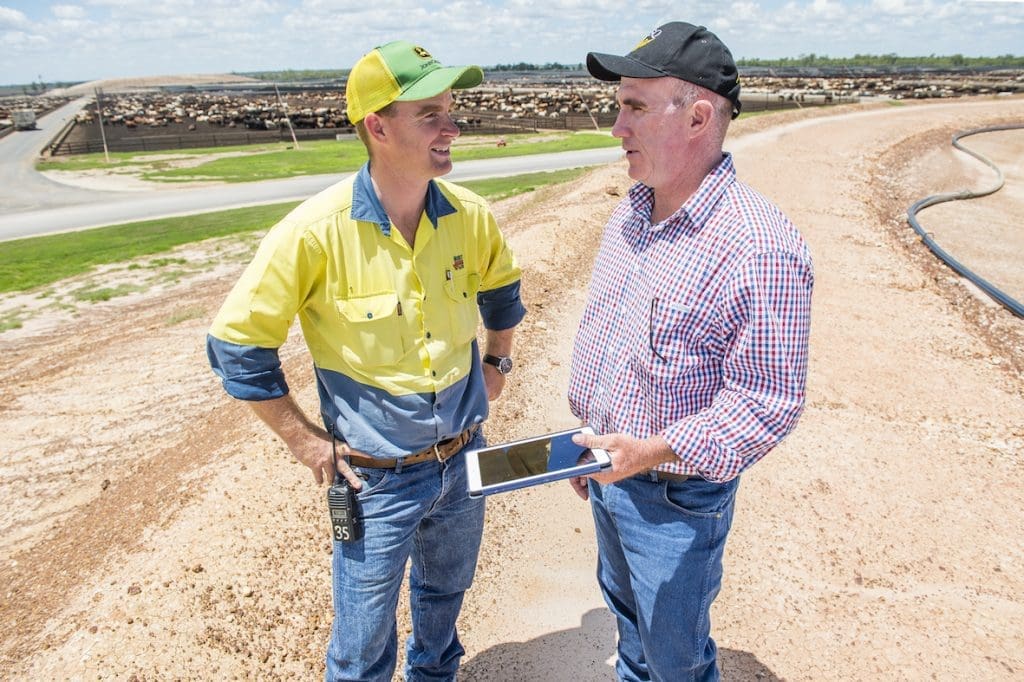
Mort & Co’s Grassdale Feedlot manager Jordan Peach (left) discusses seasonal outlooks with USQ climate scientist Dave McRae.
Major Australian lot-feeder Mort & Co has engaged the University of Southern Queensland (USQ) to provide a customised climate forecasting service to help it better manage risk in its margin-based business which turns over around 200,000 head of cattle per year and farms roughly 4,250 hectares of cereals and cotton.
Provided through USQ’s International Centre for Applied Climate Sciences (ICACS), the service involves ICACS climate scientist Dave McRae pulling together a customised domestic and international forecast relevant to Mort & Co’s operations in northern New South Wales and southern Queensland.
“It looks at climate and vegetation growth in areas across Australia as well as climate in internationally relevant places such as northern-hemisphere grain-growing regions,” Scott Braund, Mort & Co’s Toowoomba-based National Feedlot Services Manager, said.
Mr Braund said part of the USQ service’s value has come from it being a routine procedure which pulls together review and analysis of climate.
“It’s introduced a level of discipline to us where the management team has a round-table discussion about climate with Dave, and we can use what comes out of those discussions to develop risk-management strategies we can put in our toolbox.”
“This service has also upskilled our key people in terms of knowledge about what’s driving climate cycles and how to interpret climate information.”
At Mort & Co, it has transformed climate from an intra-departmental or water-cooler topic to a boardroom one, and Mr McRae said it was an example of agribusiness stepping back and overlaying their domestic perspective with a global one.
“This sort of customised climate forecasting is based on a three-month risk assessment, which might say an El Nino is likely to bring drought or challenging conditions to eastern Australia, but above-average seasonal conditions for the US, India or China,” Mr McRae said.
“As a big commodity producer and consumer, that’s quite important to Mort & Co because of their exposure to international beef and feedgrain prices.”
Mr McRae said the Madden-Julian Oscillation (MJO), which forecasts a fluctuation in tropical weather, was one of the topics discussed at meetings with Mort & Co.
“It’s a good link between short-term weather forecasts and the three to six-month outlook. It is often used as a tool by producers to do things like help identify planting opportunities, or to assist in choosing the right time to trade commodities or livestock.”
Mr McRae said the key climate indicators agribusiness throughout eastern Australia should focus on were the El Nino-Southern Oscillation (ENSO), MJO and the sub-tropical ridge of high pressure.
“These will provide the basis of any robust climate risk-management plan,” he said.
Mr McRae said those looking at using climate forecasts or information as part of their management system should give considerable thought to how key climate indicators impact on their business’ profitability and long-term sustainability.
“Regularly reviewing the latest climate patterns will provide the basis to a sound climate risk-management plan.”
“It comes down to a personal risk management strategy, and a planned approach to climate, which might enable you to take action early, or at least avoid some of the stress associated with making decisions when strongly affected by drought and ENSO.”
“It’s really about producers and agribusiness having more realistic expectations about what the climate will deliver.”
While USQ’s customised climate forecasting service does not come cheap, Mr Braund said it had helped Mort & Co make sense of the mountain of climate data which is readily available at no cost.
“Weather and climate data is so accessible — looking through it for something that’s relevant, interpreting it and taking appropriate action on it is the hard part,” Mr Braund said.
ICACS has developed a customised forecasting service to encourage agribusiness to take into account its exposure to climate risks such as drought and extreme events.
The service aims primarily to help enterprises identify their major climate risks, and facilitate the development of adaptation responses.
- See a profile on Mort & Co published in Beef Central’s Top 25 Lotfeeders report.
Source: University of Southern Queensland
